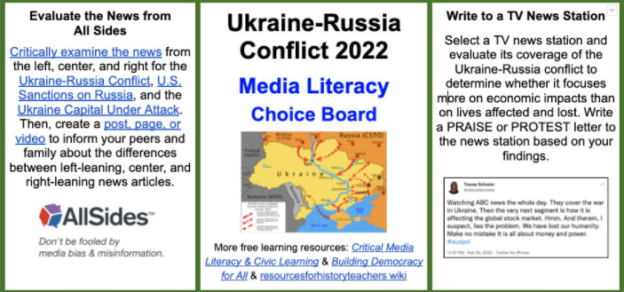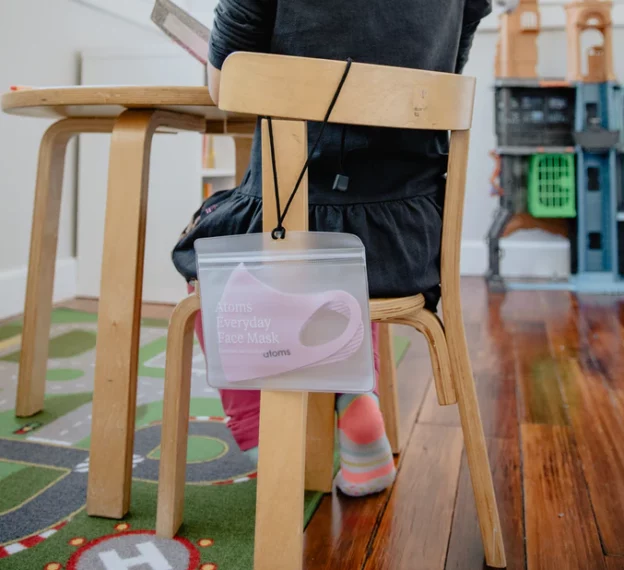At the beginning of the Russian invasion of Ukraine in late February 2022, we developed a Ukraine-Russia Conflict 2022 Media Literacy Choice Board to support students and teachers in exploring current events from a critical media literacy perspective. To engage in critical media literacy is to access, analyze, and produce a variety of media, with a particular focus on the ‘behind-the-scenes’ work of ownership, production, and distribution of media. The Ukraine-Russia Conflict 2022 media literacy choice board asks students to critically investigate and construct new ways to interact with the information about the Russian invasion of Ukraine from the news, television, social media, and other media outlets.
After sharing our Choice Board on social media and receiving an enthusiastic response, including more than 9,000 views on Twitter and 250 shares in Facebook groups for educators, we recognized that educators from across all grade levels and subjects are looking for ways to incorporate real world events into their classroom in real time. And critical media literacy is one such way to do this.
The Russian invasion of Ukraine is part of what British investigative journalist Carole Cadwalladr has called the First Great Information War – a war she believes began in 2014 when a democratically elected leader replaced an ally of Valdmir Putin as President of Ukraine. Given the ubiquity of media and the Internet, it can be easy to fall prey to the barrage of misinformation and disinformation that shapes the way in which we understand global events.
Information about the Russian invasion is coming in at a furious pace. Critical media literacy asks audiences to slow down and look closely at what is presented, watched, read, and listened to. By slowing down, and carefully analyzing texts through the tenets of critical media literacy, audiences may gather a greater understanding of both their own media use as well as the content of the events. This process is especially valuable for youth audiences for whom this may be the first global conflict with which they are grappling. Furthermore, it may be the first time that such highly contentious information pops into their social media feeds. Critical media literacy aims to support young people in their media use as well as their media understanding and sense making.
Designing Digital Choice Boards
As an interactive online visual display about a topic, digital choice boards are a powerful tool for literacy learning. With multiple entry-points for captivating the attention and interest of learners, choice boards can excite and propel student understanding and learning (Trust & Maloy, 2022).
A digital choice board can be designed using any type of word processing software or design tool – from Microsoft Word and Google Docs to Google Slides and Canva. Like traditional paper-based choice boards, digital choice boards often are set up in a grid or box-like format with each box featuring a learning activity. Digital choice boards have the added benefit of being able to include direct links to online resources and digital tools that can advance and extend student thinking and learning. The “choice” aspect of digital choice boards comes into play when students get to choose which activities they would like to complete and/or which topics they would like to explore. For example, you might ask students to complete any three boxes or have each student in a group complete 2-3 boxes and then share what they uncovered during their activities with their groups (like a Jigsaw activity).
When we design digital choice boards, we make sure each box includes the following elements: 1) interest-engaging topics and titles, 2) higher-order thinking activities, 3) hyperlinks to digital resources and/or tools, and 4) an image.
Interest-engaging topics and titles capture attention and motivate learning. For example, the title and content of the “Evaluate the News from All Sides” box on the Ukraine-Russia Conflict Media Literacy Choice Board draws attention to how news outlets don’t always paint the same picture of an event. Here we build on Maria Montessori’s focus on capturing attention and engaging students with a “point of interest” – in this case, examining how different news outlets present a current event.
Students’ engagement is not complete with just an examination of different news outlets, though. They must then think critically about what they found and consider how to present that information to friends, family, and peers through a website, image, or video. The digital choice board box includes a link to Adobe Creative Cloud Express (formerly Adobe Spark), which supports the design of these types of learning materials. Here we are guided by Bloom’s Taxonomy and how students learn more deeply when they are asked to not only understand and remember information, but to continually create, evaluate, analyze and apply information through hands-on/minds-on activities.
To engage students in higher-order critical media literacy thinking and learning, you might ask students to analyze their online search habits for a topic of interest, produce a news report about a current event, create an interactive digital story that draws connections between the past, present, and future, hand-draw an infographic to influence thinking (like William Edward Burghardt “W. E. B.” Du Bois did), or investigate an issue as a journalist. For more ideas, explore our free open access eBook Critical Media Literacy and Civic Learning.
Finally, each box contains an image as a way to excite interest, convey meaning, and invite analysis. When selecting images, we strive to find #heading=h.4uw6j1z2sc2e” target=”_blank” rel=”noopener noreferrer”>public domain images, such as those from Wikimedia Commons, and include a link to the source site for students to learn more about the image. However, if we cannot find a public domain image that is related to the topic, we will seek out an image with a #heading=h.d5qmfz2k608i” target=”_blank” rel=”noopener noreferrer”>Creative Commons license or one that is permissible within the #h2_IWir” target=”_blank” rel=”noopener noreferrer”>Fair Use doctrine.
For more examples of digital choice boards, take a look at the Black Lives Matter learning pathway and Influential Women learning pathway in our free open access eBook Building Democracy for All: Interactive Explorations of Government and Civic Life.
Critical Media Literacy in a Media-Saturated World
With our media-saturated world filled with vast amounts of disinformation and misinformation, critical media literacy activities presented in digital choice boards can inspire students to choose ways to critically interact with and construct their knowledge about global events in real time as they unfold. By engaging students in asking questions and thinking critically about the information they are getting, who is providing it to them, and why the information is provided to them, you are preparing students to become engaged citizens in a global society.
Authors
This post was written by Robert W. Maloy, Ed.D., Allison Butler, Ph.D., and Torrey Trust, Ph.D.
Robert W. Maloy is a senior lecturer in the College of Education at the University of Massachusetts Amherst where he coordinates the history teacher education program and co-directs the TEAMS Tutoring Project, a community engagement/service learning initiative 犀利士
through which university students provide academic tutoring to culturally and linguistically diverse students in public schools throughout the Connecticut River Valley region of western Massachusetts.
Allison Butler is a Senior Lecturer, Director of Undergraduate Advising, and the Director of the Media Literacy Certificate Program in the Department of Communication at the University of Massachusetts Amherst, where she teaches courses on critical media literacy and representations of education in the media. Butler co-directs the grassroots organization, Mass Media Literacy (www.massmedialiteracy.org), where she develops and runs teacher trainings for the inclusion of critical media literacy in K-12 public schools.
Torrey Trust, Ph.D. is an Associate Professor of Learning Technology in the Department of Teacher Education and Curriculum Studies in the College of Education at the University of Massachusetts Amherst. Her scholarship and teaching focus on how technology shapes educator and student learning. www.torreytrust.com

